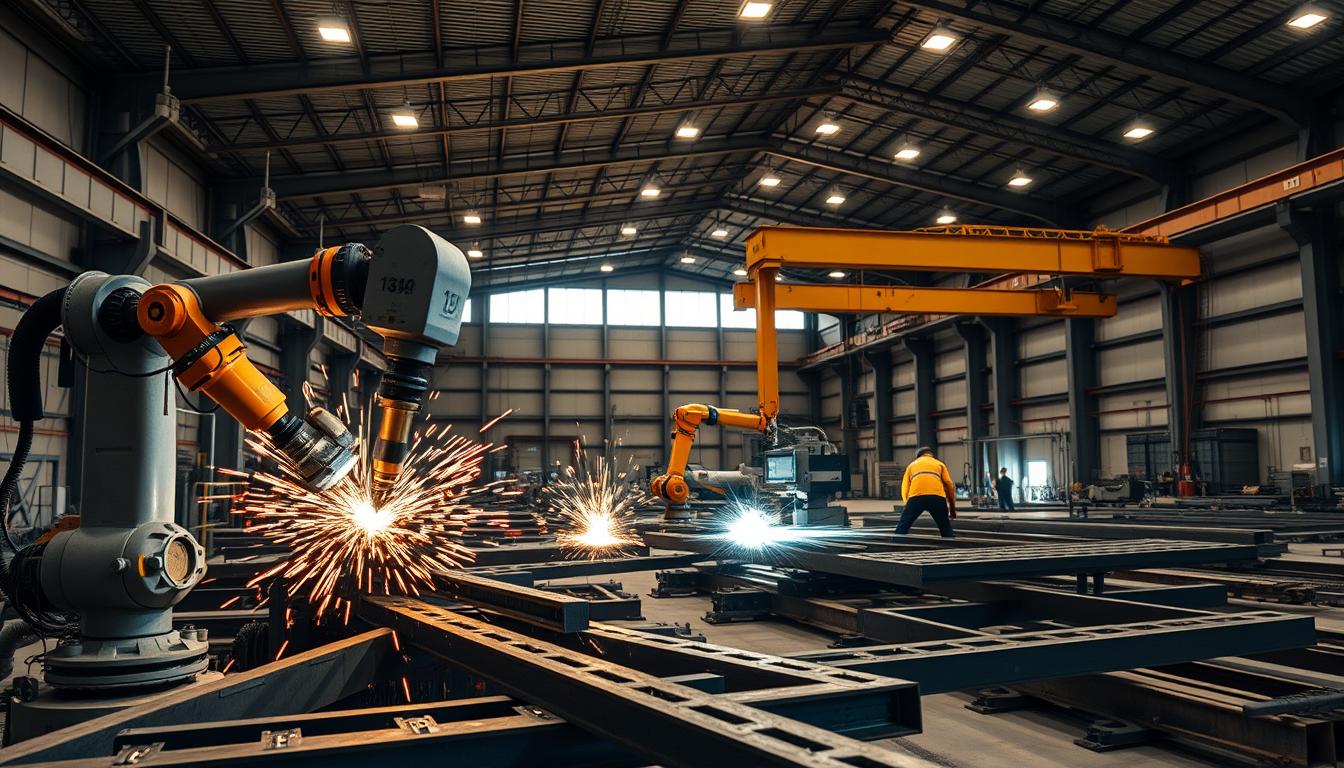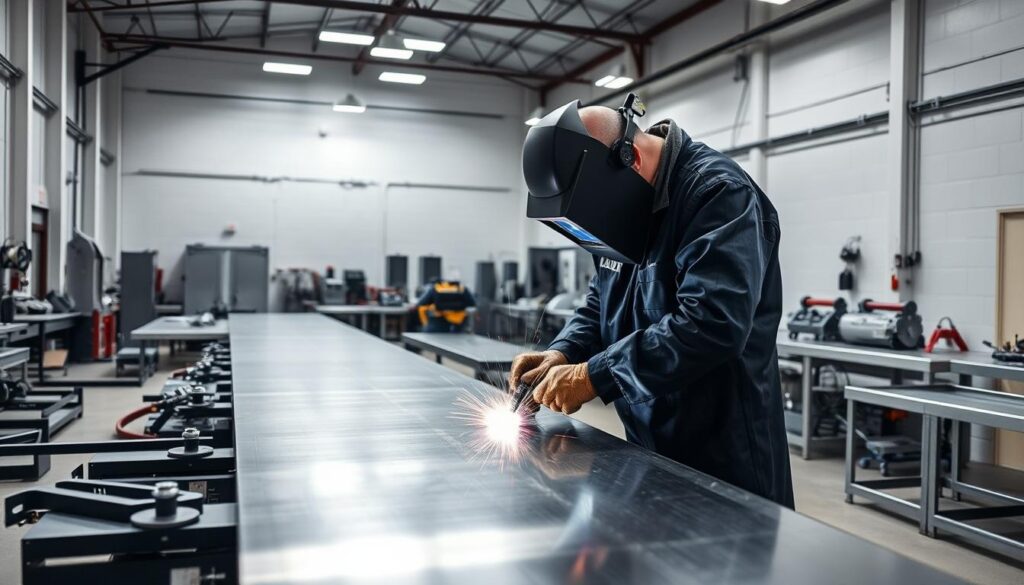The way we build with metal frameworks is changing faster than ever. New tools and methods are reshaping how professionals plan, create, and assemble these critical components. Digital systems now connect design teams with workshop floors, cutting errors and speeding up timelines.
Advanced software lets teams spot potential clashes in designs before construction starts. Cloud platforms allow real-time updates across time zones, keeping projects on track. These shifts aren’t just about fancy gadgets—they’re changing how entire teams work together.
Sustainability drives many of these changes. Factories now use smart sensors to track material use, reducing waste by up to 15%. Automated cutting machines follow digital blueprints exactly, maximizing every piece of raw material. This smarter approach helps meet tighter environmental rules without sacrificing quality.
Key Takeaways
- Digital tools now connect design and production teams seamlessly
- Real-time collaboration reduces errors and project delays
- Automated systems cut material waste significantly
- New software predicts structural issues before construction
- Sustainable practices meet stricter environmental standards
Introduction: Embracing the Future of Structural Steel
Advancements in digital tools are revolutionizing how professionals create building frameworks. Gone are days of paper blueprints and guesswork. Teams now use smart systems to turn ideas into precise plans faster than ever.
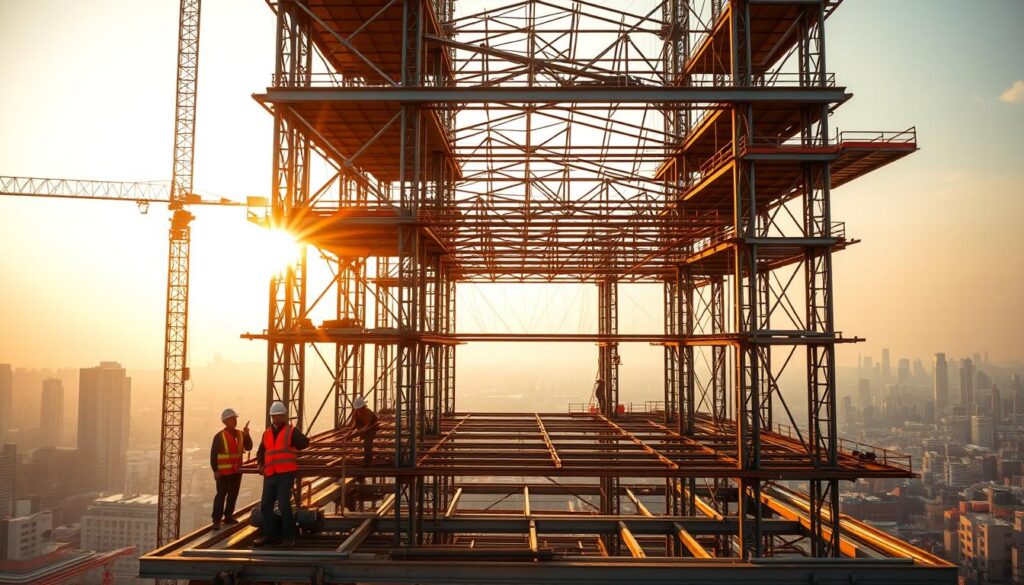
Overview of Technological Shifts
Cloud platforms connect architects, engineers, and builders in real time. Building Information Modeling (BIM) acts like a digital twin for projects. It shows every beam and bolt in 3D before workers cut metal. This prevents costly mistakes during assembly.
| Aspect | Traditional Methods | Modern Solutions |
|---|---|---|
| Design Process | Hand-drawn sketches | 3D BIM models |
| Collaboration | Weekly mail updates | Instant cloud sharing |
| Error Detection | On-site discoveries | Virtual clash detection |
Significance for Modern Construction
These tools cut project timelines by 30% in some cases. AI-powered software suggests better material layouts, reducing waste. One Chicago skyscraper team saved $1.2 million using automated detailing.
Sensors in fabrication shops track energy use and emissions. This data helps meet strict environmental rules. Real-time adjustments keep projects green without slowing progress.
Digital Transformation in Structural Steel Detailing
Modern construction teams now operate like synchronized networks, where every design decision instantly updates across departments. This shift eliminates version conflicts and accelerates project timelines through smarter workflows.

BIM Integration and Cloud Collaboration
Building Information Modeling acts as a project’s digital backbone. It stores every bolt dimension, material grade, and connection detail in one place. Teams extract 2D plans or material lists with three clicks, replacing weeks of manual drafting.
| Feature | Traditional Process | BIM Approach |
|---|---|---|
| Design Updates | 2-3 week revisions | Real-time adjustments |
| Team Coordination | Email chains | Shared cloud workspace |
| Error Detection | Field measurements | Automated clash alerts |
Smart Tools Reshaping Workflows
AI now reviews designs for potential issues before fabrication begins. One auto-detection system reduced welding errors by 40% in bridge projects. Augmented reality glasses overlay beam placements on construction sites, achieving millimeter-level precision.
Cloud platforms let engineers in Texas tweak a column design while fabricators in Ohio adjust cutting patterns simultaneously. This always-on collaboration slashes approval delays, helping teams meet tight deadlines without compromising quality.
Innovations in Structural Steel Detailing and Fabrication
The construction world is witnessing a fundamental shift in how teams approach framework creation. Gone are ink-stained drafting tables and manual measurement tools—today’s workshops hum with digital precision that merges design intent with production realities.
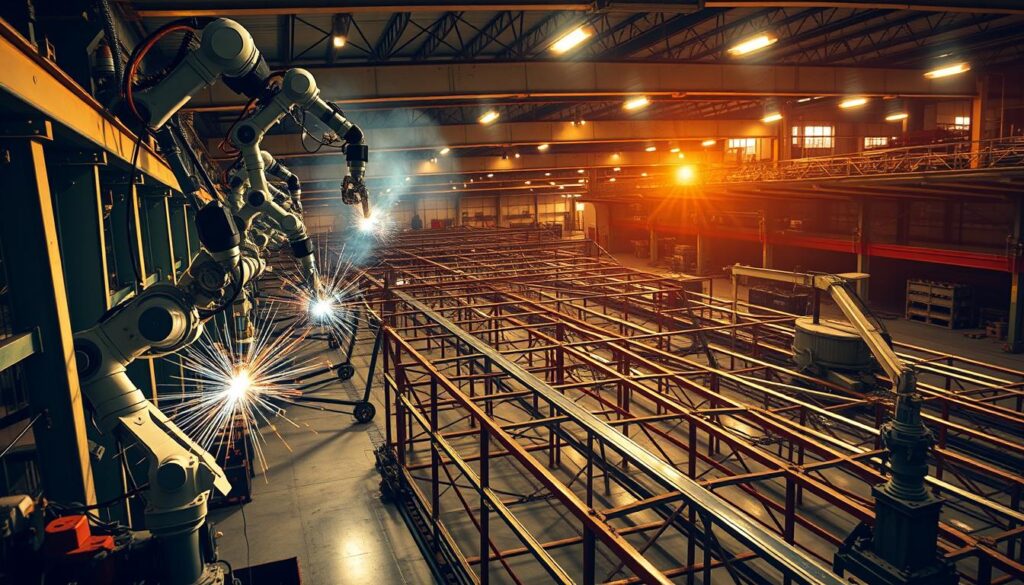
Defining the New Era in Steel Detailing
Modern workshops replaced parallel bars with parametric modeling systems. These tools automatically adjust beam connections when column positions change. One Milwaukee fabricator reduced rework by 62% using this approach.
Artificial intelligence now reviews designs for material optimization. A recent stadium project used machine learning to trim 18 tons of excess metal without compromising safety. “The software suggested connections we’d never considered,” noted the lead engineer.
Impact on Efficiency and Precision
Automated detailing slashes production timelines. Shop drawings that took three weeks now generate in 48 hours. Laser-cut components arrive at job sites with QR codes linking to installation videos.
| Aspect | 1980s Approach | 2020s Method |
|---|---|---|
| Design Changes | 2-week redrafting | 15-minute model update |
| Error Rate | 12% of projects | 1.8% of projects |
| Custom Components | 6-week lead time | 5-day production |
This evolution empowers smaller shops to tackle complex projects. A Texas family business recently fabricated curved trusses for an airport canopy—work previously reserved for industrial giants. Democratized technology reshapes competitive landscapes while raising quality standards industry-wide.
Advanced Fabrication Techniques and Software Solutions
Metal construction has transformed from pencil-and-paper methods to digital precision. Modern shops combine cutting-edge tools with smarter workflows, turning complex designs into reality faster than ever.
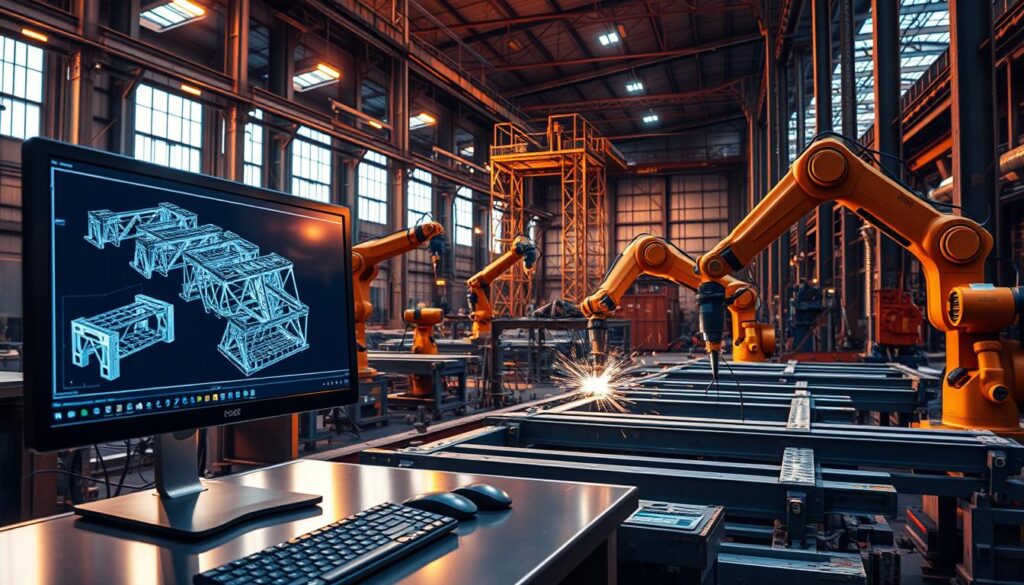
Evolution from Manual Drafting to CAD and 3D Modeling
Drafting tables once dominated workshops. Teams spent weeks correcting measurement errors. Now, 3D models show every angle before metal gets cut. One Detroit fabricator reduced design revisions by 75% after switching to digital tools.
CAD systems detect clashes between components automatically. This prevents costly rework during assembly. Updated plans sync instantly across teams through cloud platforms.
Leading Tools Reshaping the Industry
Five programs stand out in modern metalwork:
| Software | Key Feature | Annual Cost |
|---|---|---|
| Tekla Structures | Full BIM integration | $7,500 |
| Advance Steel | Automated drawings | $2,200 |
| Bocad Steel | FIM compatibility | Custom quote |
Autodesk’s Advance Steel creates shop drawings in half the traditional time. “We complete stadium projects three weeks faster now,” reports a Texas fabricator using the tool.
These solutions help teams meet tight deadlines while maintaining strict quality standards. Real-time collaboration features ensure everyone works from the latest plans, reducing confusion on busy job sites.
Sustainable Practices and Green Production in Steel Construction
Environmental priorities now shape every phase of metal framework creation. Digital tools and eco-conscious strategies merge to build smarter while protecting resources. This shift helps teams meet strict regulations and client demands for greener projects.
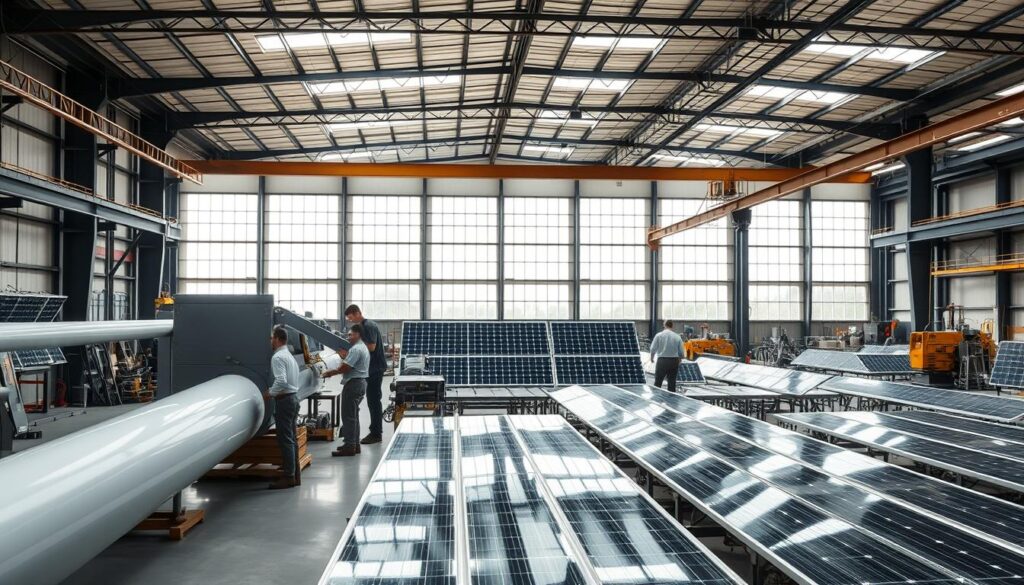
Renewable Energy Integration in Fabrication
Modern plants power operations using sunlight and wind. Solar arrays cover factory roofs, while wind turbines spin beside loading docks. Electric arc furnaces melt scrap metal using clean energy, cutting emissions by 75% compared to coal-based methods.
One Ohio facility runs entirely on renewables during daylight hours. “Our energy bills dropped 40% after installing solar panels,” reports their plant manager. Smart grids balance power use across welding stations and CNC machines.
Eco-Friendly Materials and Reduced Emissions
Recycled content now dominates production lines. Over 90% of beams and plates come from reprocessed metal. High-strength alloys let builders use less material without compromising strength.
| Factor | Traditional Steel | Green Steel |
|---|---|---|
| CO2 Emissions | 1.85 tons/ton | 0.45 tons/ton |
| Recycled Content | 30% | 98% |
| Energy Source | Coal | Wind/Solar |
Precision software minimizes offcuts during cutting. One stadium project saved 28 tons of steel through optimized nesting patterns. These approaches help fabricators meet sustainability targets while maintaining profit margins.
Automation and CNC Machining in Modern Fabrication
Factories now operate with robotic precision, transforming raw metal into complex components through programmed commands. This shift redefines how teams approach construction projects, merging digital accuracy with industrial scale.
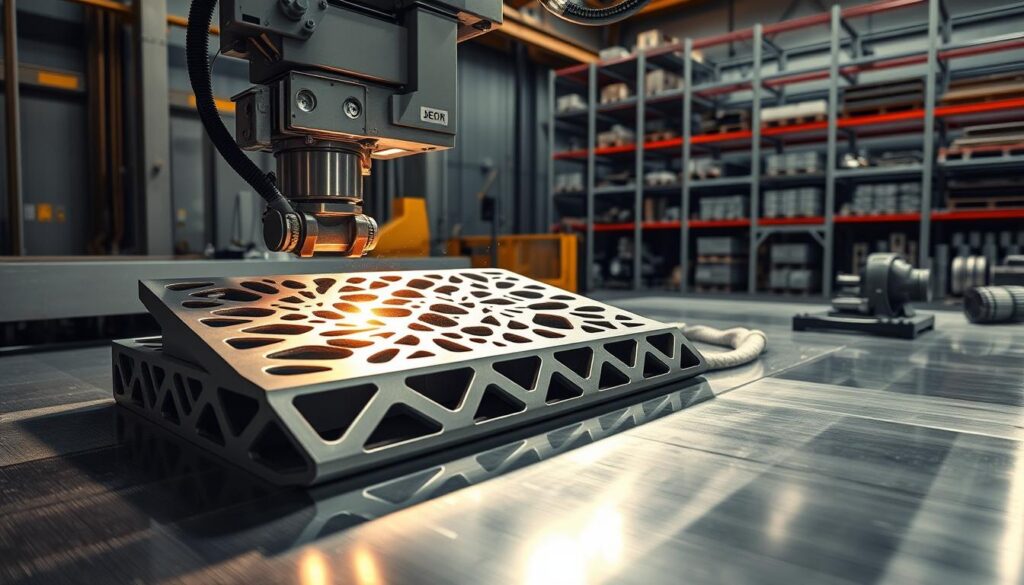
Enhancing Precision with CNC Technology
Computer Numerical Control systems eliminate measurement guesswork. Cold roll formers shape C/Z purlins within 0.5mm tolerances—thinner than a credit card. Auto-pinch systems hold materials steady during shearing, ensuring identical roof panels for skyscrapers.
Folding machines craft custom clips and trims using 3D models. “We produce anchor bolts with thread patterns that manual methods couldn’t replicate,” shares a Michigan plant supervisor. Laser cutters follow digital templates, slicing intricate patterns without overheating metal.
Streamlining Production Processes
Automated workflows slash lead times. What took three workers eight hours now completes in 90 minutes with one technician. Nesting software arranges parts like puzzle pieces, reducing material waste by 22% in bridge projects.
Cloud-connected machines adjust cutting paths mid-job if designs change. Waterjet systems switch between steel grades without retooling. This flexibility lets shops handle urgent orders while maintaining quality standards across all manufacturing processes.
The Role of BIM in Connecting Construction Teams
Modern construction thrives on synchronized teamwork across disciplines. Building Information Modeling acts as the industry’s digital backbone, linking architects, engineers, and fabricators through shared data streams. This unified approach ensures all stakeholders work from identical specifications.
Centralizing Information for Better Outcomes
BIM platforms store every bolt dimension and material grade in one accessible hub. Contractors in Chicago can view real-time design updates made by detailers in Atlanta. Cloud-based collaboration eliminates version conflicts that once caused costly delays.
Artificial intelligence enhances these systems by flagging potential clashes early. A New York high-rise team recently avoided 83 structural conflicts using automated alerts. Augmented reality tools overlay 3D models onto job sites, improving installation accuracy for complex steel structures.
This centralized method breaks down silos between departments. Changes to beam connections automatically update shop drawings and material lists. Fabricators receive precise cutting instructions the moment engineers finalize designs.
The result? Faster approvals, fewer errors, and tighter project timelines. Teams now tackle intricate designs with confidence, knowing their shared digital foundation keeps everyone aligned from blueprint to bolt-up.

